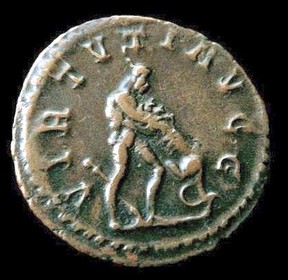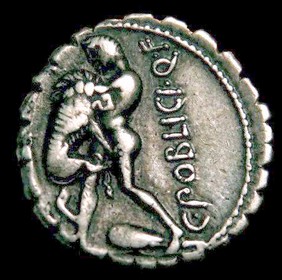| Depictions
of Hercules as reverse coin-type were popular during the Republican era
until the time of Constantine the Great. Hercules is usually recognised
by his muscular physique and his attributes of a club and lion-skin. He
appears on early republican coins of the gens Publicia, who gained prominence between the first and second Punic wars.
Moneyers from this family group depicted Hercules naked,
wrestling the Nemean lion, showing a club at his feet, as shown on
the coin right. The obverse depicts a helmeted Roma. The coin alludes to Pompey's command in Spain. It was
probably issued in 80 BC, the year during which Sertorius started his
rebellion against Sulla. It took Pompey eight years to finally crush
this rebellion.
The use of Hercules iconography continued during the Imperial era. At
the time this demi-god was not only identified as divine protector of a
particular gens, but also of the emperor. When Diocletian established
the tetrarchy, different deities represented the status of each
emperor. The two senior consuls, Diocletian and Maximian, for instance,
adopted the iconography of Jupiter, and of Hercules as Jupiter's son,
respectively.
On an antoninianus of Maximian Herculius (left), Hercules is shown
strangling a lion. The imagery is still unchanged, but artistically of
inferior value than in previous centuries. |



